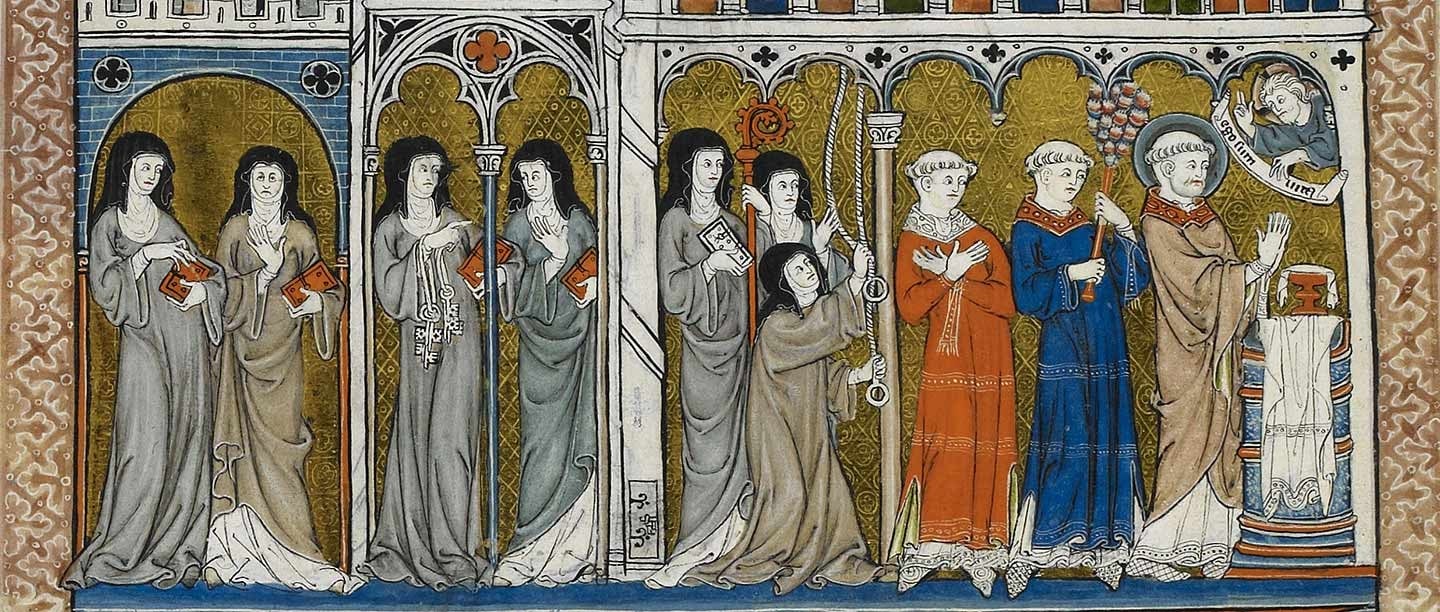Beginnings
Women have been involved in monasticism since its origins in the late Roman Middle East. Starting in the late 3rd century, women such as Syncletica of Alexandria, Theodora of Alexandria and Sarah of the Desert chose to live as hermits in the deserts of Egypt, Palestine and Syria. Here they escaped the temptations and luxuries of the sinful world and lived austere lives dedicated to prayer and the service of Christ. Called the ‘Desert Mothers’ by some modern historians (the founders of male monasticism are known as the ‘Desert Fathers), their ‘sayings’ or teachings were recorded and esteemed by their followers.
Communities of religious women soon formed. The two dominant monastic ‘Rules’ (collections of precepts for communal monastic life) during the Middle Ages were the Rule of St Augustine and the Rule of St Benedict. Both St Augustine of Hippo (354–430) and St Benedict of Nursia (480–547) had sisters who were nuns, and St Scholastica (c.480–543), Benedict’s sister, came to be venerated as the ‘founder’ of female Benedictine monasticism.
Anglo-Saxon origins: double monasteries
When St Augustine and his companions landed in Kent in 597 in their mission to convert the Anglo-Saxons to Christianity, their reception was friendly. This was arguably because of Queen Bertha (d. c.601), wife of King Æthelberht of Kent (d.616). Already a Christian, Bertha was a Frankish princess, and her family’s realm (what is now northern France) was a cradle of monasticism. The earliest known Anglo-Saxon nunneries in southern England were in Kent, all of them being founded either by the reigning king or a female relative.
But the most distinctive type of nunnery founded in England in the 7th century was the ‘double monastery’ – a community consisting of both nuns and monks, living strictly segregated lives, with an abbess as its head. Between 657 and 660 a double house at Chelles, near Paris, was founded by St Balthilde, who was the wife of the Frankish king Clovis II and was of Anglo-Saxon birth. This soon provided a model for similar double monasteries in Anglo-Saxon England.
Probably the most famous was the monastery founded by St Hild at Whitby (in what is now North Yorkshire) in about 657. Her monastery achieved fame across Europe for its sanctity and learning and played an important role in the evangelisation of the north. St Hild was born a princess and her monastery at Whitby was intimately connected with the ruling dynasty of the Northumbrian kingdom. For that reason, in 664, the abbey was the location for the so-called Synod of Whitby, called by King Oswiu of Northumbria to settle the rivalry between the two strands of Christianity in England – Irish-influenced and Roman – over aspects of Christian custom.
The monastery at Wenlock (Shropshire) likewise had its origins as a double house with a high-born abbess at its head. Founded by Merewalh, a sub-king of Mercia, in about 670–80, its first abbess is likely to have been a nun at Chelles. She was succeeded as abbess by St Milburga, the daughter of Merewalh and his queen, Domne Eafe (who was also a founder of monasteries). Indeed, Wenlock may well have been founded to enable Milburga to pursue a monastic vocation; two of her sisters also became nuns.
Raids and renewal
The double house at Whitby did not survive the Viking raids of the 9th century, and nuns ceased to be part of the community at Wenlock at some point after about 901. After the Norman Conquest, both sites were subsequently resettled by monks, who were responsible for the impressive ruins you can see today.
The destruction and disruption caused by the Viking invasions had a serious impact on monasteries – many were destroyed, and there was a decline in the quality of observance and scholarship in the survivors.
The general revival of monastic life in southern England in the 10th century included the foundation of nunneries. Like their 7th-century predecessors, these nunneries, including Shaftesbury and Wilton, had royal connections. Their purpose was to pray for the souls of their royal founders, and to provide the daughters of the Anglo-Saxon elites with either the opportunity to fulfil a religious vocation or a refuge if they were considered unmarriageable. They also bolstered the esteem and status of the founders, helping to secure their dynastic and territorial claims.
Post-Conquest nunneries
The violence of the Norman Conquest meant that numbers at these nunneries were swelled by the widows and daughters of the Anglo-Saxon aristocracy. The foundation of new nunneries started in the late 11th century. Although occasionally drawn from the ecclesiastical and military elite, for the most part the founders were from the knightly, second-tier class. This had predictable consequences for the wealth of the 100-plus nunneries established between the 12th and early 13th centuries. In many instances, their landed endowment was as scant as any surviving documentary record.
White Ladies Priory (Shropshire) is typical. Also known as the Priory of St Leonard in Brewood, it was a monastery of Augustinian canonesses, or nuns. It was known as White Ladies because of the colour of their habits, or clothing, and to distinguish the monastery from the nearby Benedictine convent of St Mary, Brewood (Benedictines wore black habits).
The date of White Ladies’ foundation is uncertain, as is the identity of its founder. A document from 1186 mentions the priory as being already in existence, and architectural details from what survives of the nuns’ church date to the late 12th century. This period was the high-water mark for monastic foundations in England, including nunneries.
Almost all these nunneries were priories, with a prioress at their head – an indication of their relatively lowly status: priories were usually smaller than abbeys and sometimes subordinate to them. The White Ladies community typically consisted of five or so nuns and the prioress; only a minority of post-Conquest nunneries had more than a dozen or so nuns.
The nuns’ daily lives
There were many similarities between the daily lives of medieval nuns and monks. Their day consisted of three components – singing eight services in praise of God, devotional reading and manual labour. Nuns were expected to sleep in a communal dormitory and dine in a communal refectory. Conversation was all but forbidden, so too private property.
However, as women, nuns could not be ordained priest and celebrate Mass (most monks took holy orders). Their devotional reading was often in English rather than Latin. Their strict rules of enclosure meant that they were forbidden to leave the confines of the monastery and undertake tasks in the wider community.
Image: A marginal drawing from a 14th-century manuscript showing a friar hearing a nun’s confession
© British Library (Stowe MS 17 fol 191r)
Lapses in discipline
Like nunneries across the land, White Ladies was intimately connected with local knightly families, many of whom bestowed gifts on the monastery when their daughters entered its cloister. Even so, the periodic visitations, or formal inspections, conducted by the Bishop of Lichfield or his representative suggest that the nunnery struggled to live within its slender means.
Records of visitations from other nunneries have led some modern historians to paint a bleak picture of the standards of religious life among many medieval nuns. There are instances of nuns being admonished for changing their habits to resemble dresses worn by laywomen; keeping pet dogs and rabbits; gossiping and forming cliques; absconding and abandoning their monastic vows; and worst of all, having illicit sexual relationships and becoming pregnant.
Although no major breaches of discipline were documented at White Ladies, two of its nuns are known to have abandoned their monastic vows and left the convent without permission – a serious sin. Such instances are unsurprising given that many nuns did not have a religious calling and had been placed in nunneries by their families because they could not be married off.
The nuns of Denny
But there is considerable evidence that paints a much more positive picture of life within nunneries and the status of nuns in wider society. Denny Abbey (Cambridgeshire) is a good example. A house of Poor Clares, or Franciscan nuns, it was founded by Mary de Valence, a rich and pious widow. The nuns arrived at Denny (previously home in turn to Benedictine monks and Knights Templar) in 1342. Mary de Valence visited the nunnery several times and was built a suite of apartments for this purpose. She died in 1377 and was buried wearing the habit of a Franciscan nun before the high altar at Denny.
The Denny community consisted of the daughters of the East Anglian gentry and urban elites, who much esteemed the nuns’ prayers and left bequests to the nuns asking for them to pray for their souls. It was a large community, typically consisting of several dozen nuns. Margery Kempe (c.1373–1438), the famous mystic and pilgrim, travelled to Denny to seek the spiritual counsel of its nuns.
Like nunneries across the land, the abbey also acted as a sort of elementary and ‘finishing’ school. Indeed, nunneries provided a standard of female education not attained again in England until the 18th century. Nunneries were also important local employers and landlords. The servants at Denny included both men and women.
In about 1512 Elizabeth Throckmorton, a member of a rising Warwickshire gentry family, became abbess of Denny. She corresponded with Erasmus, the leading scholar of the age. A manuscript book containing religious verse now at the Bodleian Library, Oxford, has her ownership inscription and speaks of her piety, erudition and learning.
The Dissolution and after
Religious life at Denny had ended by 1539 when the abbey, like monasteries across England, was suppressed on the orders of Henry VIII. Events at Denny around this time provide evidence for both negative and positive interpretations of the history of England’s medieval nuns.
Visiting Denny five years earlier, the royal commissioners had encountered half a dozen tearful nuns who wanted immediate release from their vows – evidence that many medieval nuns lacked a genuine vocation. However, when the abbey’s end came, Elizabeth Throckmorton, accompanied by two or more of her nuns, retired to her family manor at Coughton Court (Warwickshire). There they continued to live according to their monastic vows while wearing the brown habits of Franciscan nuns.
In this they were not alone. Four nuns of Kirklees Priory (West Yorkshire) banded together to live a quasi-monastic life at a nearby manor house after the closure of their monastery. And the community of Syon Abbey (Middlesex) went into exile abroad en masse rather than abandon their vows. They retained an unbroken thread as a religious community until 2011, when dwindling numbers caused the final closure of their abbey.
By Michael Carter
Top image: Nuns at Mass, depicted in a late 13th-century manuscript
© British Library (Yates Thompson MS 11 fol 6v)
Find out more
-
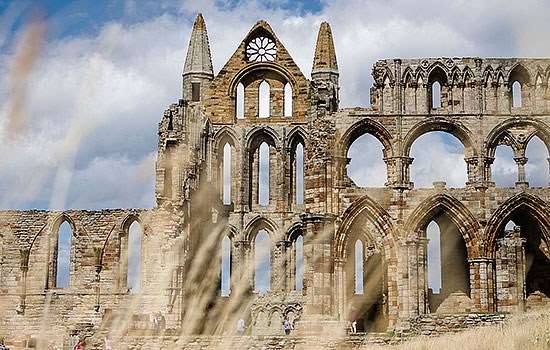
ABBEYS AND PRIORIES
Learn about England’s medieval monasteries and uncover the stories of those who lived, worked and prayed in them.
-
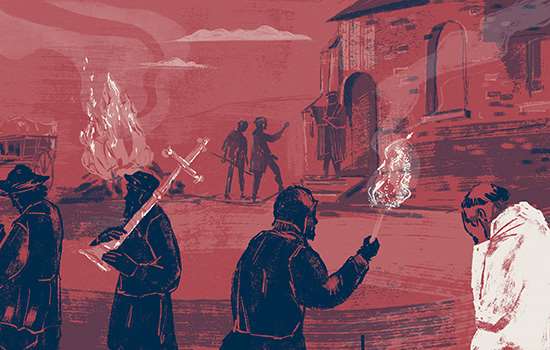
WHAT BECAME OF THE MONKS AND NUNS AT THE DISSOLUTION?
Discover what happened to the many thousands of monks and nuns whose lives were changed forever when, on the orders of Henry VIII, every abbey and priory in England was closed.
-
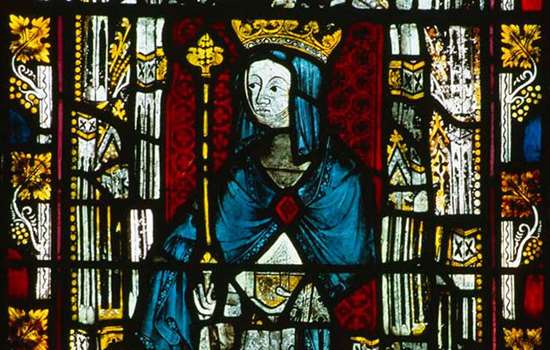
St Hild
As abbess of Whitby – a monastery for both men and women – Hild led one of the most important religious centres in the Anglo-Saxon world.
-
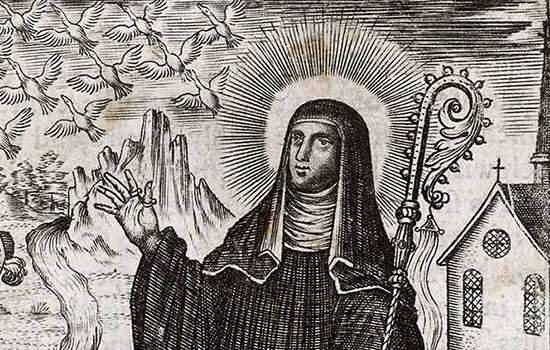
St Milburga
Read more about St Milburga, Anglo-Saxon princess, abbess and miracle worker, who ruled over a community of both monks and nuns.
-
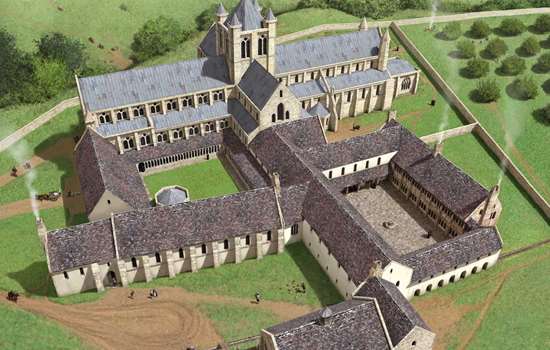
History of Wenlock Priory
Discover the full history of the double monastery where Milburga presided as abbess, as well as the priory refounded soon after the Conquest on its site.
-
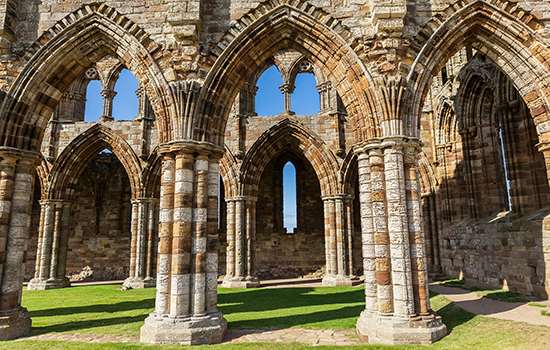
History of Whitby Abbey
Read a comprehensive overview of Whitby’s history, from the 7th-century monastery to the excavations that have helped us to understand the site today.
-
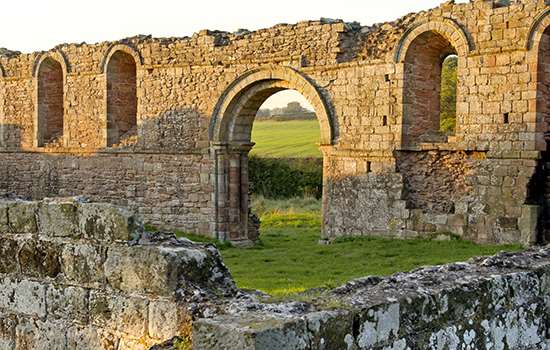
History of White Ladies Priory
Discover more about the history of the priory, which later became famous when Charles II took refuge there in 1651 after the Battle of Worcester.
-
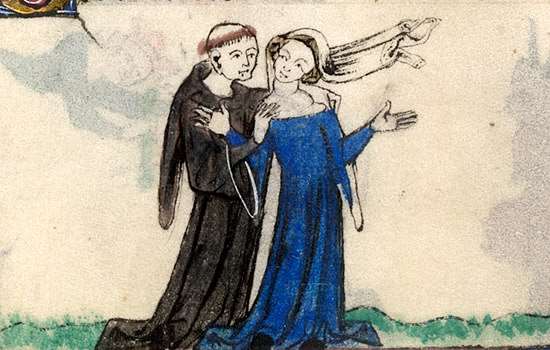
Women in male monasteries: an illicit presence?
Strict rules were in place to ensure that monks had minimal contact with women in medieval monasteries. But could they even have functioned without women?
